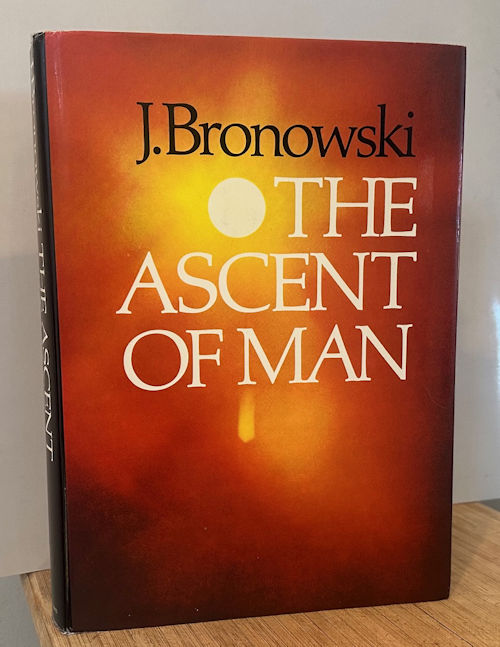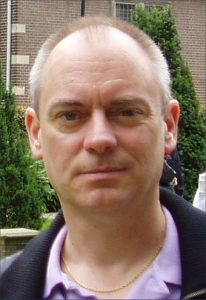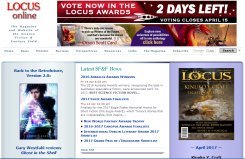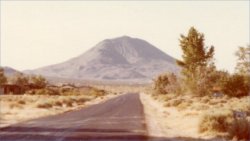(Little, Brown, 1973, 448pp, including 9pp (in tiny print) of bibliography and index)
This is a substantial book that was popular in its time but is probably not really recommendable now, simply because it’s 50 years out of date in those sections that impinge on current science. (That’s the first problem.) It was a big deal in the 1970s because it was the book companion to a 13-part BBC TV series (it would have been on PBS in the States) by a well-known erudite mathematician/historian, who hosted and narrated the show as it was filmed in various spots around the world. It followed the similar series CIVILISATION by Kenneth Clark, and was followed by three or four similar shows, including Carl Sagan’s CONTACT in 1980. Television was in its first prestige period, and least with public television, in that it could finance big-budget documentaries like these.
And therein lies the second problem.
The author notes that the text of the book is virtually unchanged from the show’s script, aside from a tense references and so on. Thus the structure of the book reflects the structure of the show, which focused on events that happened at those various spots. Thus, in this book we learn probably too many details about Galileo’s trial before the Inquisition than we need to know (we get pages of transcript), and too many technical details about breeding hybrid garden peas, which Gregor Mendel did, than we need to know. Presumably Bronowski was standing in the room where the trial was held, and later standing in Mendel’s monastery room, when he discussed these topics on camera. The book is heavily illustrated with diagrams and shots from the filmed locations.
I probably saw the show and read the book when they came out in the ’70s. I don’t have a recording of the show but I did find a couple episodes of it on YouTube, and watched the first, here.
It’s worth looking through the book at least in summary to see what topics Bronowski chose to consider as representing the “ascent” of man (meaning of course humanity, men and women, but “man” was the all-purpose word for the species back then; I’ll follow suit in the summary here). Especially given that the previous series, Kenneth Clark’s CIVILISATION, confined itself entirely the *western* civilisation, from Rome to the present, with virtually no acknowledge of Asia or the Americas or anywhere else, and with an apparent fondness for cathedrals. (Also, Bronowski chose “ascent” in the title as a deliberate counterpoint to Darwin’s famous book.)
Ch1, Lower than the Angels
About the evolution of man beginning in Africa. This is the weakest chapter since so many more details about this period have been discovered in the past 50 years; Bronowski uses obsolete terms like Peking Man and Proconsul, and didn’t know about the other cousin species, along with Neanderthal, that have been discovered in recent decades. (See Harari.) Still, the best part of Bronowski is his philosophical purview. Art and science both involve the ability to visualize the future, he writes; “Cultural evolution is essentially a constant growing and widening of the human imagine.” [[ And this of course fits nice with my big theme of how science fiction fits into everything. ]]
Ch2, The Harvest of the Seasons
About agriculture. How biological evolution took millions of years; cultural evolution has occurred only over the past 12,000 years or so. Most of this is familiar, but Bronowski recognizes none of the downfalls of sedentary life, as dwelled upon by Harari.
Ch3, The Grain in the Stone
About structures built of rock, Machu Picchu and Greek structures built with beams, and Roman structures built with arches, first semicircles and later ovals, enabling all those huge cathedrals. Freemasons are what those traveling construction workers were called.
Ch4, The Hidden Structure
How fire inspired alchemy; it doesn’t just destroy, it transforms. Copper the earliest metal known, but like the other pure metals (silver, gold) too soft to take an edge; until the discovery of alloys. From iron came steel, and Japanese swords. Alchemy focused on mercury and sulfur, then salt. The discovery that air is composed of different gases. The idea of atoms.
Ch 5, The Music of the Spheres
Mathematics, number systems, Pythagoras and harmony in nature. His proof. Euclid’s elements of geometry. Ptolemy’s theory that everything revolved around the Earth was wrong, but it lasted 1400 years. Rome fell, with the help of Christianity; Islam became the center of the scientific world, building mechanical computers, simplifying Roman numerals with Arabic numbers. Christianity return to Spain; ancient Greek texts translated into Latin, and the discovery of perspective in painting, Kepler realized the true motions of the planet; Newton and Leibniz invented calculus.
Ch6, The Starry Messenger
Astronomy was the first science in the modern sense, since its observations could be turned into exact numbers. All cultures keep calendars to manage the plant and the harvest. Copernicus put the sun at the center in 1543, but waited years to publish, fearing church backlash. Galileo bought a spyglass in Venice in 608 and saw Jupiter’s moons. He created the modern scientific method. Galileo was naive thinking people could be persuaded by evidence; anyone against the church was a heretic. He was put on trial and forced the recant.
Ch7, The Majestic Clockwork
The center of gravity of the civilized world shifts to northern Europe. Newton born 1642. He calculated the force of gravity, worked in optics, did experiments to prove his ideas. Newton assumed that space was flat and infinite; that universe lasted 200 years, until Einstein, whose ideas were extrapolated from Michelson’s experiment showing the speed of light was the same in all directions. What would it be like to ride on a beam of light? It led to the conclusion that there is no universal time. Relativity.
Ch8, The Drive for Power
The Industrial Revolution began around 1760, just before two others: the American in 1776, the French in 1789. In England. Working at home was no longer sufficient, and that was work in poverty and darkness; by 1820 workers went to factories. The revolution came from machines: the mill, the water wheel. Canals (called ‘navigation’) were built across England. In America Benjamin Franklin wrote his almanack, realized lightning was electricity. Iron boats, iron architecture. Mass production came from factories that were ghastly. The cardinal sin became idleness; everything was about extracting power from nature, ideas reflected in poetry of the time. Lots of wacky invention; then the railroads. We’re still in the Industrial Revolution, which has brought about social and intellectual equality, and established the unity of nature.
Ch9, The Ladder of Creation
Evolution: Darwin, and Wallace. On Darwin’s trip on the Beagle he realized species were not immutable, but new of no mechanism to drive them apart. When he did, he didn’t publish. Wallace traveled to the Amazon to collect specimens for museums. When he contacted Darwin back in England, they published a paper, that went unnoticed; so Darwin wrote his book, published in 1859. So: the world is not static. How to tell what came before? Look to chemistry. Much richer evidence for evolution accumulated over the next century. Amino acids, the early atmosphere of Earth, Stanley Miller’s experience, the four bases of DNA.
Ch10, World Within World
Elements were discovered and found to be ordered by Mendeleev, in a table with gaps that implied new elements would be found. Electrons were discovered; atoms weren’t indivisible after all. Thus began modern physics: a great collective work of proposed models and bigger and bigger machines to test predictions of new particles. The atom was imagined to be a little solar system, with electrons circling the nucleus, moving from one orbit to another, each quantum jump corresponding to a particular color of light. Neutrons were discovered, fired at atoms to deduce their structure. Hydrogen became helium in stars; then in turn into heavier atoms like carbon, all the way to uranium. Is the universe running down? No; statistics allows order to be build in some places while disorder takes over in others. [[ this was the key concept of the Greene and Hidalgo books read last year. ]] Evolution is a ladder of such steps, which author calls “stratified stability.”
Ch11, Knowledge or Certainty
Physics in the 20th century showed there is no absolute knowledge, that all information is imperfect. We need shorter waves of light to see small things, but no matter how precise our instruments, things still look fuzzy. Debates about electrons (particles or waves?) led to Heisenberg’s uncertainty principle, or principle of tolerance. By this time Hitler and others were coming to power — ironically, in displays of monstrous certainty. Leo Szilard and information theory, he tried warning Roosevelt. But the bomb was dropped on Hiroshima anyway. The human dilemma has two parts: the belief that the ends justify the means, and the assertion of dogmas that close the mind. It is not science that dehumanizes people; science is a form of knowledge, open to error and the possibility that we are wrong.
Ch12, Generation Upon Generation
Gregor Mendel and genetics, the basis for the modern life sciences. He flunked school and became a monk, studying garden peas. He published his results, and no one cared (and the other monks didn’t like it). It took decades for his work to be noticed, which explained how sex produces diversity, the propeller of evolution. Eventually these ideas were married to the understanding of DNA, and how a child inherits genes from both parents. Oddly, the author muses, many creation myths seem to yearn for an ancestral clone — Eve cloned from Adam’s rib, e.g. And he speculated how matches between suitable males and females drove the pace of human evolution. [[ This last seems naive now, given the nuances of modern evolutionary psychology. ]]
Ch13, The Long Childhood
Man is both a social and solitary animals. Human culture, the mind, is plastic. Art and science are both expressions of this mind. The brain isn’t just a computer; it’s a learning machine. Specific areas control certain functions. E.g. the mind is wired to learn language. It has functions for thinking about the future. People can postpone gratification. Childhood, puberty, youth is about learning how to do this. Hamlet is about trying to reach a decision–until it’s too late. We revere our children. Civilizations fall when they limit the freedom of the imagination of the young. Yet most sons do what their fathers did. Only a minority learn new things, ascend ladders of promotion. In the church, that ladder ends with “now that shalt not question.” The democracy of the intellect comes from the printed book. Thus the age-old conflict between intellectual leadership and civil authority. A scientific society is one in which specialists do their work, but everyone understands how nature works. “You cannot possibly maintain that informed integrity if you let other people run the world for you while you yourself continue to live out of a ragbag of morals that come from past beliefs.” 436.8 A knowledge of man’s origins must become commonplace or we shall not exist. Author is saddened to see a retreat in the west: into Zen Buddhism, false profound questions, extra-sensory perception. “Self-knowledge, at last bringing together the experience of the arts and the explanations of science, waits ahead of us.” Civilization is in a balance. If we give up, some other culture will take our place, in Africa or China.
\\
This last chapter is prescient: the modern US is abandoning knowledge right and left, in favor of civil authoritarianism and all sorts of woo beliefs. And indeed we may be handing the world to China. He understands the point that Pinker was at pains to explain in THE BLANK SLATE 20 some years later. There’s also the flavor of Wilson’s CONSILIENCE here: that art and science together form the basis of a mature culture.






